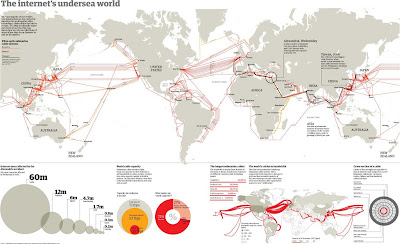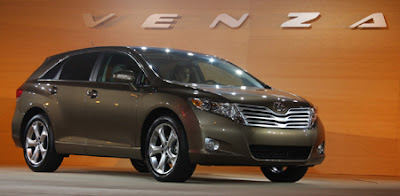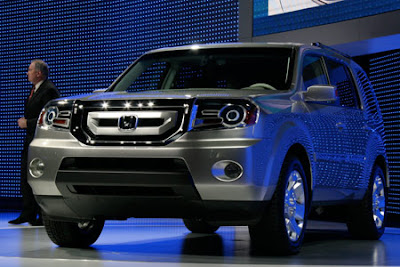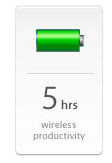 Everyone complains of high prices and the low quality of service they get… & how we are still stuck with lower-than-world-average speeds - 128K, 256K & 512K.
Everyone complains of high prices and the low quality of service they get… & how we are still stuck with lower-than-world-average speeds - 128K, 256K & 512K.
The most basic unlimited offer, i.e. Wanadoo ADSL 128Kbps, starts at Rs. 750. This connection is supposed to be reliable 24/24 7/7… meaning you should be getting a permanent 128kbps connection.
The other popular offer is the My.T 256Kbps, which is also unlimited & the price is still Rs. 750. But the big difference is that My.T is a Quality of Service offer which does not guarantee maximum speeds at peak hours.
(I’m not considering any other ISPs, because MT has a monopoly over Internet)
During the past few months, I’ve seen an acute deterioration of my internet speed at specific hours. At first I thought that it was something to do with the server from which I’m downloading… but very soon I had to admit it was the connection that was faulty. No matter what server I downloaded from, no matter how many threads/parallel connections I used with download managers, the result was always the same - I’m getting speeds between 4 to 9KB/s. The average speed of a 128K connection is between 11 to 16KB/s. So I’m getting half the speed I’m paying for.
 The peak hours are on weekdays between 15.00 to 18.00 & during past two week-ends from 13.00 to 18.00. (This week-end, speed was great - that's my top speed above) These are exactly the times when most users are on the Internet. One more thing I’ve noticed is that the speed gets back to normal at the very instant when the clock ticks 18.00… probably when the businesses shut down?
The peak hours are on weekdays between 15.00 to 18.00 & during past two week-ends from 13.00 to 18.00. (This week-end, speed was great - that's my top speed above) These are exactly the times when most users are on the Internet. One more thing I’ve noticed is that the speed gets back to normal at the very instant when the clock ticks 18.00… probably when the businesses shut down?
 This chart shows the level of priority to Internet access. Though I have not included it, the topmost rung consists of ISPs & VOIP companies that purchase bandwidth directly from MT on SAFE. & we common Internet users are found at the very bottom. At peaks, it’s only after all these businesses get their reserved bandwidth that we, common unimportant mortals, get a piece of the cake… Half the speed we are paying for… We are only cash-cows and are certainly not entitled to a decent speed.
This chart shows the level of priority to Internet access. Though I have not included it, the topmost rung consists of ISPs & VOIP companies that purchase bandwidth directly from MT on SAFE. & we common Internet users are found at the very bottom. At peaks, it’s only after all these businesses get their reserved bandwidth that we, common unimportant mortals, get a piece of the cake… Half the speed we are paying for… We are only cash-cows and are certainly not entitled to a decent speed.
 A look at the top speed found in Mauritius… where are the 1Mbps & 512Kbps connections? Actually, the top speed of a 512K is 320Kbps… Why?
A look at the top speed found in Mauritius… where are the 1Mbps & 512Kbps connections? Actually, the top speed of a 512K is 320Kbps… Why?
 The SAFE cable has a capacity of around 130Gbit/s. Considering that the bandwidth is shared between South Africa, Reunion & Mauritius & half of it for international traffic, Mauritius has around 10 to 20 Gbps bandwidth. After removing all those dedicated access & companies that purchase their own bandwidth, this translates into around 5 Gbps of bandwidth for the people, i.e 5,000Mbps = 5,000 1Mbps connection = 50,000 512Kbps connections!!!
The SAFE cable has a capacity of around 130Gbit/s. Considering that the bandwidth is shared between South Africa, Reunion & Mauritius & half of it for international traffic, Mauritius has around 10 to 20 Gbps bandwidth. After removing all those dedicated access & companies that purchase their own bandwidth, this translates into around 5 Gbps of bandwidth for the people, i.e 5,000Mbps = 5,000 1Mbps connection = 50,000 512Kbps connections!!!
& considering that we have around 300,000 Internet users & 22,000 broadband subscribers, the conclusion is simple - we are running out of bandwidth.
This explains just about everything.
We are getting low speeds at the peak hours, because the network is at its limit, & that’s what had happened during the past two week-ends when everyone accessed the Internet at the same time.
Why are prices extremely high? The sales price of a 128K connection is around Rs. 500 & that of 512K around Rs. 900…
Why is MT so aggresively promoting My.T & NetPC, offers with network-dependent speeds? Why is the price of ADSL 128K the same as My.T 256K while My.T offers thrice more services?
The truth is… to discourage people from subscribing to broadband connections. MT knows that the network has reached its almost full capacity.
 Eassy, the solution?
Eassy, the solution?
Eassy - the problem with Eassy is that it will be shared by a large number of countries & so Mauritius won’t have any significant gain in speed. If you were thinking that with Eassy, you’d be getting a 1Mbps connection at Rs. 500, dream on… that’s still decades away.
 Africa & the Indian Ocean is the world’s poorest region in terms of fibre connectivity. No wonder Africa is always behind. What we need is more fibre-optic links. But the problem is that there’s always more talk than action… no one really wants to invest.
Africa & the Indian Ocean is the world’s poorest region in terms of fibre connectivity. No wonder Africa is always behind. What we need is more fibre-optic links. But the problem is that there’s always more talk than action… no one really wants to invest.
UCL is considering investing into an island-wide Fibre-To-Home network in Mauritius… but who would want a FTTH connection that gives you a 128Kbps international speed?
http://en.wikipedia.org/wiki/Communications_in_Mauritius
http://en.wikipedia.org/wiki/Eassy
http://en.wikipedia.org/wiki/SAFE_%28cable_system%29
http://www.internetworldstats.com/africa.htm
The Mauritian Dream
Bilan of Internet Service Providers (ISP) in Mauritius
Update: Map of all Fibre-Optic links in the world

Update: According to Le Matinal, the Indian Ocean Commission (ICO) is organising meetings to discuss the possibility to invest into a SAFE-like Fibre Optic Cable that will link all Indian Ocean islands to the rest of the world.
My advice: Just do it!
Update 2: Akamai caching websites in Mauritius...
(2010) Update 3:
Sorry, but this whole article is rubbish. Really. At the time this was posted, I had a very crude knowledge of how the network was built. So actually I was very much wrong. Although SAFE has reached its limit, the problem is with the old local infrastructure. It can't handle peaks. With the arrival of Eassy (1Mbps at Rs 1000), it has slightly improved but you do still notice slowdowns. However, gradually, users are being migrated to FTTC. Until all users are on the FTTC network, these slowdowns will continue, no matter how many fibre optic cables are connected to Mauritius...
Read More






 The Tata Nano, the world’s cheapest car, the People’s car, the impossible dream made true…
The Tata Nano, the world’s cheapest car, the People’s car, the impossible dream made true… The People’s Car, as Ratan Tata describes it, is a 1-Lakh rupee car ($2500 - £1250 - Rs.75000). It has a 623cc 33hp rear engine, brakes, a four-gear manual transmission, seatbelts, locking, wind-down windows, a steering wheel & is 3,100,000,000 nanometres long. It has also a small boot at the front. That’s in the standard version (red car).
The People’s Car, as Ratan Tata describes it, is a 1-Lakh rupee car ($2500 - £1250 - Rs.75000). It has a 623cc 33hp rear engine, brakes, a four-gear manual transmission, seatbelts, locking, wind-down windows, a steering wheel & is 3,100,000,000 nanometres long. It has also a small boot at the front. That’s in the standard version (red car).

 The deluxe version (yellow car) has air conditioning & some other options.
The deluxe version (yellow car) has air conditioning & some other options. Even the deluxe version is extremely stripped-down…
Even the deluxe version is extremely stripped-down…



 Detroit 08 was not only a showcase for General Motors & other US manufacturers with their pick-up trucks, crossovers & SUVs - the Germans & the Japanese were there as well. However it was Audi that mesmerized the show with its diesel-powered Audi R8…
Detroit 08 was not only a showcase for General Motors & other US manufacturers with their pick-up trucks, crossovers & SUVs - the Germans & the Japanese were there as well. However it was Audi that mesmerized the show with its diesel-powered Audi R8… No need to present the ZR1… it’s best supercar made in the US. & this new version of the ZR1 is just as stunning. Carbon fibre body, carbon ceramic disc brakes & the 6.2-litre supercharged V8 LS9 (620hp). The Corvette ZR1 is a pure muscle car!
No need to present the ZR1… it’s best supercar made in the US. & this new version of the ZR1 is just as stunning. Carbon fibre body, carbon ceramic disc brakes & the 6.2-litre supercharged V8 LS9 (620hp). The Corvette ZR1 is a pure muscle car! This is an eco-friendly fuel efficient sedan concept that Ford hopes to sell in 2010. The design is quite good & it’s supposed to have a 4-cylinder engine & PowerShift dual clutch transmission.
This is an eco-friendly fuel efficient sedan concept that Ford hopes to sell in 2010. The design is quite good & it’s supposed to have a 4-cylinder engine & PowerShift dual clutch transmission. Lexus have some competition in the luxury sedan section with the Hyundai Genesis that wants to become the next LS400. & it has all those luxury items like cooled & heated seats, adaptive headlights, sat-nav, backup camera, cruise control & Lexicon 7.1 stereo system. Watch out for these!
Lexus have some competition in the luxury sedan section with the Hyundai Genesis that wants to become the next LS400. & it has all those luxury items like cooled & heated seats, adaptive headlights, sat-nav, backup camera, cruise control & Lexicon 7.1 stereo system. Watch out for these!
 The new 2009 Ford F-150 comes in different looks, & is expected to be as best-selling as the previous version (it’s the best-selling pickup in the US). & I must admit it has great looks!
The new 2009 Ford F-150 comes in different looks, & is expected to be as best-selling as the previous version (it’s the best-selling pickup in the US). & I must admit it has great looks! This is it!!! In addition to the GT-R & the R8, Porsche 911s now have to contend with the LF-A series… The Lexus LF-A Roadster is as good as the original LF-A coupe, if not better with that stunning red colour! & the engine is a 5-litre V10 with transmission at the back, with a power rating at 500hp. Toyota is back!!!
This is it!!! In addition to the GT-R & the R8, Porsche 911s now have to contend with the LF-A series… The Lexus LF-A Roadster is as good as the original LF-A coupe, if not better with that stunning red colour! & the engine is a 5-litre V10 with transmission at the back, with a power rating at 500hp. Toyota is back!!! Great cheers to Land Rover’s Design team for bringing out a new life out of those boring Land Rover’s. How about a Defender concept?
Great cheers to Land Rover’s Design team for bringing out a new life out of those boring Land Rover’s. How about a Defender concept? The best concept in Detroit… front design is awesome! Although it doesn’t have a proper engine (with only 450hp), it would be great if Mazda could just tweak it a little bit more & it would be a race car to contend with (in the likes of the Pagani Zonda?)
The best concept in Detroit… front design is awesome! Although it doesn’t have a proper engine (with only 450hp), it would be great if Mazda could just tweak it a little bit more & it would be a race car to contend with (in the likes of the Pagani Zonda?) Toyota have presented this crossover that is expected to rival Nissan’s Murano. Not bad.
Toyota have presented this crossover that is expected to rival Nissan’s Murano. Not bad. Ferrari goes green! Well, not exactly… this F430 runs on E85 (85% ethanol & 15% gasoline), which results in a 10hp power increase and only 5% fuel economy.
Ferrari goes green! Well, not exactly… this F430 runs on E85 (85% ethanol & 15% gasoline), which results in a 10hp power increase and only 5% fuel economy. There’s nothing special about this pickup except the way it was presented at Detroit. A large herd of cattle was made to stampede through Detroit streets as the Dodge Ram 2009 was unveiled.
There’s nothing special about this pickup except the way it was presented at Detroit. A large herd of cattle was made to stampede through Detroit streets as the Dodge Ram 2009 was unveiled. The Honda Pilot is a SUV with Honda's ACE (Advanced Compatibility Engineering) safety technology and VCM cylinder deactivation management system. The Variable Cylinder Managaement system allows this V6 to run on 6, 4 or 3 cylinders depending on the need. Wow! That should drastically reduce fuel consumption. The design is not that good with those upward-looking headlights.
The Honda Pilot is a SUV with Honda's ACE (Advanced Compatibility Engineering) safety technology and VCM cylinder deactivation management system. The Variable Cylinder Managaement system allows this V6 to run on 6, 4 or 3 cylinders depending on the need. Wow! That should drastically reduce fuel consumption. The design is not that good with those upward-looking headlights. This is the hybrid crossover, which BMW presented last year at Frankfurt, now in production version.
This is the hybrid crossover, which BMW presented last year at Frankfurt, now in production version. The Audi TT-S is the new version of the Audi TT with 265hp, large 19-inch wheels & a dual-clutch automatic allowing 0-100 in 5.2s.
The Audi TT-S is the new version of the Audi TT with 265hp, large 19-inch wheels & a dual-clutch automatic allowing 0-100 in 5.2s. A sports coupe concept that shows off the blending of aluminium, carbon & plastic. Hope it stays as a concept…
A sports coupe concept that shows off the blending of aluminium, carbon & plastic. Hope it stays as a concept… Hummer & eco-friendly are two words that are poles apart… but against all odds, Hummer have managed it with this E85 flex-fuel concept. The design is great… let’s hope now that the US Army will consider using this design in its future Hummers!
Hummer & eco-friendly are two words that are poles apart… but against all odds, Hummer have managed it with this E85 flex-fuel concept. The design is great… let’s hope now that the US Army will consider using this design in its future Hummers! Unfortunately there was no Reventón on display at Detroit, but Lamborghini have announced that they will be launching the Ad Personam program where customers will be able to customise the colours & the interior of their Lamborghinis.
Unfortunately there was no Reventón on display at Detroit, but Lamborghini have announced that they will be launching the Ad Personam program where customers will be able to customise the colours & the interior of their Lamborghinis. I think Toyota have created this concept to allow Top Gear to reach the South Pole. Unlike what it suggests, this really fat truck is a hybrid & has solar panels as well!
I think Toyota have created this concept to allow Top Gear to reach the South Pole. Unlike what it suggests, this really fat truck is a hybrid & has solar panels as well! Yet another SUV, but this one is a really cool concept (except for the “humped” bonnet)
Yet another SUV, but this one is a really cool concept (except for the “humped” bonnet) This Zeo concept is an electric car that provides 64KWh to the rear wheels via a 265hp engine. It can cover 250 miles before it runs out of juice.
This Zeo concept is an electric car that provides 64KWh to the rear wheels via a 265hp engine. It can cover 250 miles before it runs out of juice. Bumblebee was there as well!!!
Bumblebee was there as well!!! The R8 V12 TDI is a concept that melds the 6.0L V-12 diesel engine from last year’s Q7 concept with the award winning R8 sports car.
The R8 V12 TDI is a concept that melds the 6.0L V-12 diesel engine from last year’s Q7 concept with the award winning R8 sports car. The concept engine shares a cylinder count with the race-winning R10, but it's actually a completely new engine with a 60-degree bank angle instead of the 90 degrees used on the race engine. While the 500 hp is only par for the course in its class, the 738 lb-ft of torque is enough to shred all four tires with ease.
The concept engine shares a cylinder count with the race-winning R10, but it's actually a completely new engine with a 60-degree bank angle instead of the 90 degrees used on the race engine. While the 500 hp is only par for the course in its class, the 738 lb-ft of torque is enough to shred all four tires with ease. While the R8 V12 TDI storms to 62mph in 4.2 seconds and maxes out at 186mph, it also manages to get 23 MPG. The combination of a 29,000-psi direct-inject fuel injection system, particulate filters and urea injection allows this beast to pass 2014 EuroVI emissions standards, too.
While the R8 V12 TDI storms to 62mph in 4.2 seconds and maxes out at 186mph, it also manages to get 23 MPG. The combination of a 29,000-psi direct-inject fuel injection system, particulate filters and urea injection allows this beast to pass 2014 EuroVI emissions standards, too.


 The Macbook air is an ultra-thin Macbook at 0.16 inches (4 mm) at its thinnest & 0.76 inches (19 mm) at its thickest, making it the thinnest laptop in the world. So thin… that it can fit in a manila envelope.
The Macbook air is an ultra-thin Macbook at 0.16 inches (4 mm) at its thinnest & 0.76 inches (19 mm) at its thickest, making it the thinnest laptop in the world. So thin… that it can fit in a manila envelope.
 It has a 13.3 inch widescreen display, a backlit keyboard & a multi-touch trackpad. The multi-touch trackpad allows the user to reciprocate the same hand motions as with the iPhone - pinch, scroll, drag, etc. There’s also an iSight webcam at the top of the screen.
It has a 13.3 inch widescreen display, a backlit keyboard & a multi-touch trackpad. The multi-touch trackpad allows the user to reciprocate the same hand motions as with the iPhone - pinch, scroll, drag, etc. There’s also an iSight webcam at the top of the screen. The Macbook Air comes with an 1.8-inch 80GB hard disk (as in the iPods) or a 64GB SSD.
The Macbook Air comes with an 1.8-inch 80GB hard disk (as in the iPods) or a 64GB SSD. The Intel Core 2 Duo processor has been shrunk down by 60% to provide a speed of 1.6GHz & 1.8GHz!!!
The Intel Core 2 Duo processor has been shrunk down by 60% to provide a speed of 1.6GHz & 1.8GHz!!!
 To make the Macbook Air really thin, you have to shrink down the electronics… & Apple engineers have just managed it!
To make the Macbook Air really thin, you have to shrink down the electronics… & Apple engineers have just managed it!
 It has a single USB 2.0, Micro-DVI & headphone jack. There’s also the 802.11n WiFi (248 Mbit/s!!!) & the latest Bluetooth 2.1!
It has a single USB 2.0, Micro-DVI & headphone jack. There’s also the 802.11n WiFi (248 Mbit/s!!!) & the latest Bluetooth 2.1!
 Unfortunately, there’s no optical drive & the battery lasts only for 5 hours. But you can get an optional $99 USB external DVD burner.
Unfortunately, there’s no optical drive & the battery lasts only for 5 hours. But you can get an optional $99 USB external DVD burner. Height: 0.16-0.76 inch (0.4-1.94 cm)
Height: 0.16-0.76 inch (0.4-1.94 cm) - Intel Core 2 Duo processor with 4MB on-chip shared L2 cache
- Intel Core 2 Duo processor with 4MB on-chip shared L2 cache - 80GB 4200-rpm Parallel ATA hard disk drive
- 80GB 4200-rpm Parallel ATA hard disk drive - 13.3-inch (diagonal) glossy widescreen TFT LED backlit display with support for millions of colours
- 13.3-inch (diagonal) glossy widescreen TFT LED backlit display with support for millions of colours - Built-in full-size keyboard with 78 (U.S.) or 79 (ISO) keys, including 12 function keys, 4 arrow keys (inverted “T” arrangement), and embedded numeric keypad
- Built-in full-size keyboard with 78 (U.S.) or 79 (ISO) keys, including 12 function keys, 4 arrow keys (inverted “T” arrangement), and embedded numeric keypad - Built-in AirPort Extreme Wi-Fi wireless networking (based on IEEE 802.11n draft specification); IEEE 802.11a/b/g compatible
- Built-in AirPort Extreme Wi-Fi wireless networking (based on IEEE 802.11n draft specification); IEEE 802.11a/b/g compatible - Analog audio output/headphone out (minijack)
- Analog audio output/headphone out (minijack) - Integrated 37-watt-hour lithium-polymer battery
- Integrated 37-watt-hour lithium-polymer battery
 - MacBook Air
- MacBook Air

 The only people I know, that are crazy enough (or fool enough) to buy that… are Americans. Apple were caught in between UMPC & laptop… they didn’t know what to make… so they decided to bring out a laptop with the features of a UMPC - the Macbook Air.
The only people I know, that are crazy enough (or fool enough) to buy that… are Americans. Apple were caught in between UMPC & laptop… they didn’t know what to make… so they decided to bring out a laptop with the features of a UMPC - the Macbook Air. See you next year, Steve Jobs!
See you next year, Steve Jobs!